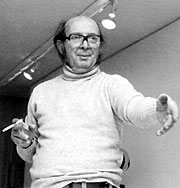He was born in Rosario in 1905 and began his studies in that city. In 1925, he obtained a scholarship that allowed him to travel to Europe and to attend the workshops given by André Lhote and Othon Friesz.
In Paris, he got in touch with metaphysical painting and surrealism, besides adhering to the idea of artistic action committed to political and social reality. On his return to Argentina in 1930, he worked on surrealist paintings and collages that he exhibited in Buenos Aires in 1932.
The international and, particularly, the national crisis influenced his poetic which turned to critical realism, showing his social concerns. In 1933, he met Mexican artist Siqueiros, who introduced him to the concept of mural art at the service of communitarian issues. Since then and due to the lack of public walls, he worked on compositions of great dimensions that dealt with the conflicts of the lower classes on a monumental scale.
In 1941, a scholarship granted by the Comisión Nacional de Cultura enabled him to travel throughout Latin America and to study its art. In 1943 he obtained the Honorary Grand Prix at the Salón Nacional. In 1944, together with Spilimbergo, Castagnino, Urruchúa and Colmeiro he founded the first Mural Art workshop, with which the following year he decorated the dome of the Galerias Pacifico.
In the fifties, he began a series devoted to the humblest settlers of Argentina –ainly of Chaco and Santiago del Estero– focused on the phenomenon of internal migrations.
In 1959, he returned to collage, a technique that he would use in works featuring Juanito Laguna, the boy from the slums and Ramona Montiel, the prostitute. His choice of waste materials became significantly contextual. On the one hand, metal sheets, cardboard, wood and surplus industrial materials were to depict the fate of Juanito. On the other hand, embroidery, plastic nails or paper and cheap furniture mouldings predominate in that of Ramona.
He won the Grand Prix for Engraving at the Venice International Biennial in 1962. His engravings were also recognised at the Ljubljana and Cracow International Biennials and at the Berlin Intergrafik. He renewed xylography, introducing collage and prominent reliefs ("xylo-collage-reliefs"), besides making prints of unusual proportions.
In 1965, a retrospective of his work was organised at the Instituto Di Tella, where he displayed his poly-materic Monsters. Versions of this exhibition were shown in Argentina, the United States and several other Latin American countries. That same year, he was appointed Honorary Member of the Florence Accademia delle Arti del Disegno.
Since 1967, he worked on multimedia settings such as Ramona en la caverna (Ramona in the cavern), El mundo de Ramona (Ramona's world) or La masacre de los inocentes (The massacre of the innocent). The latter was exhibited in his 1971 retrospective at the Paris Museum of Modern Art.
In the seventies he used elements taken from photographic realism, although he did not abandon his inclination for Expressionism. Works of this type were exhibited in New York in 1977. These resources nourish both Juanito's and Ramona's compositions, which were by then acquiring ever greater relief, becoming almost modern altarpieces. Following this style and reflecting popular cults, in 1976, he produced the setting dedicated to La difunta Correa.
In 1979, he was appointed member of the Academia Nacional de Bellas Artes.
In 1980, with Apocalipsis (Apocalypse) and La crucifixion (The Crucifixion) he culminated the remarkable paintings destined to decorate the Chapel of San Luis Gonzaga Institute in Las Heras, located in the Province of Buenos Aires, which were installed there the following year.
He died in Buenos Aires on October 13th 1981. On November 17th, the Monument to Martín Fierro, on which he was working, was inaugurated in San Martín, in the Province of Buenos Aires.
